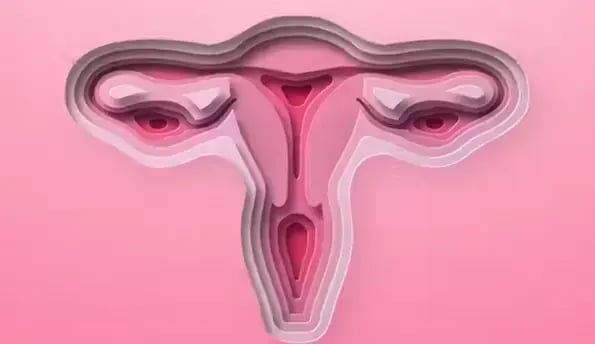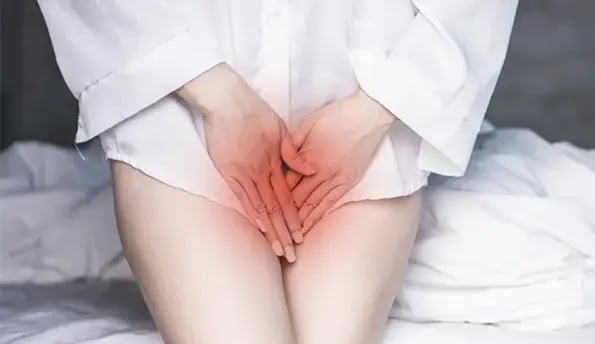What Vaginal Changes Can a Person Expect After Giving Birth?
Postpartum Vaginal Changes: What to Expect After Giving Birth
After giving birth, a person may experience a variety of vaginal changes and symptoms. It's important to remember that every individual's experience can be different, and not everyone will experience all of these changes. The extent and duration of these changes can also vary. Here are some common vaginal changes and symptoms that may occur after childbirth:

Vaginal Width:
During childbirth, the vaginal canal can stretch significantly to accommodate the passage of the baby. While the vagina typically has good elasticity and can return to near its pre-pregnancy state, some individuals may notice changes in vaginal width, especially immediately after giving birth. Vaginal swelling after giving birth is a common and expected occurrence. It is typically caused by a combination of factors, including the stretching and trauma to the vaginal and perineal tissues during childbirth, increased blood flow to the area, and the body's natural healing process. This swelling can be uncomfortable but usually resolves on its own as the body heals.
Ice packs, Warm baths, Pain relief, Rest, Kegel exercises, Good hygiene, Proper positioning, and Loose-fitting clothing can help and vaginal swelling is a normal part of the postpartum recovery process, but it should gradually improve over time. If you have any concerns or questions about your postpartum recovery, be sure to reach out to your healthcare provider for guidance and support.
Our mission is to create a world where every investment in modern beauty is Worth It.
Let's keep in touch
Get updates of the treatments you are interested
Dryness:
Hormonal changes, particularly a drop in estrogen levels, can lead to vaginal dryness. This can result in discomfort or pain during intercourse. Using a water-based lubricant can help alleviate this issue.
To address vaginal dryness after giving birth, consider the following:- Lubricants: Using water-based or silicone-based lubricants can help alleviate vaginal dryness and discomfort during sexual activity.
- Kegel Exercises: Pelvic floor exercises, known as Kegel exercises, can help improve blood flow and muscle tone in the pelvic area, potentially aiding in vaginal lubrication.
- Talk to Your Healthcare Provider: Discuss your concerns with your healthcare provider. They can offer advice and recommendations tailored to your specific situation, such as prescribing topical estrogen creams or hormone therapy if necessary.
- Stay Hydrated: Drinking plenty of water can help maintain overall body hydration, including the vaginal area.
- Non-Hormonal Moisturizers: You can use over-the-counter, non-hormonal vaginal moisturizers to provide relief from dryness. These are different from lubricants and are designed for regular use to maintain vaginal moisture.
- Time and Patience: Remember that your body needs time to recover after childbirth, and hormonal levels may normalize over time. Vaginal dryness can improve as your body adjusts to its postpartum state.

Soreness and Stitches:
Our mission is to create a world where every investment in modern beauty is Worth It.
Let's keep in touch
Get updates of the treatments you are interested
Bleeding:
After giving birth, it is common for women to experience postpartum bleeding, also known as lochia. This natural phenomenon is the body's way of shedding the uterine lining that supports the pregnancy. Postpartum bleeding can be categorized into three distinct phases, each with its own characteristics and duration.
The first phase, known as lochia rubra, typically lasts for the first 3-5 days after delivery. During this time, the bleeding is bright red in color and is quite heavy. This phase is the body's way of expelling any remaining blood and tissue from the uterus.
Following the lochia rubra phase, women enter the lochia serosa phase, which can last up to 10 days. During this phase, the bleeding becomes lighter in color, transitioning to a pink or brownish hue. It also tends to be less in volume as the body continues to heal.
The final phase is lochia alba, which can last for several weeks. During this stage, the bleeding becomes much lighter and is more of a white or yellowish discharge. This phase signifies the completion of the healing process and the return to a more normal menstrual cycle.

Pain During Sex:
After giving birth, many women may experience pain during sex, a condition known as dyspareunia. This discomfort can be attributed to several factors, both physical and psychological. Physically, the body undergoes significant changes during pregnancy and childbirth, which can affect the pelvic floor muscles, leading to discomfort and pain during intercourse. The stretching and tearing of these muscles during childbirth can result in soreness and sensitivity, making intimacy challenging.
Additionally, hormonal fluctuations can contribute to vaginal dryness, leading to friction and discomfort during sex. Psychological factors can also play a role, as new mothers may experience anxiety, fear, or stress related to their postpartum bodies and the impact on their self-esteem and body image.
Addressing this issue requires open communication between partners and seeking professional guidance when necessary. Many women find relief through physical therapy to strengthen pelvic floor muscles or through the use of lubricants to combat dryness. In some cases, counseling or therapy may be helpful to address any psychological factors contributing to the pain. It's essential for new parents to prioritize their sexual and emotional well-being, as a healthy, fulfilling sex life can play a significant role in maintaining a strong and connected relationship during the postpartum period.
Our mission is to create a world where every investment in modern beauty is Worth It.
Let's keep in touch
Get updates of the treatments you are interested
Periods:

Urinary Incontinence:
Orgasm Changes:

Vulvar Color:
Postpartum Recovery:
Contacting a Doctor:
Postpartum Vaginal Changes: What to Expect After Giving Birth
After giving birth, a person may experience a variety of vaginal changes and symptoms. It's important to remember that every individual's experience can be different, and not everyone will experience all of these changes. The extent and duration of these changes can also vary. Here are some common vaginal changes and symptoms that may occur after childbirth:

Vaginal Width:
During childbirth, the vaginal canal can stretch significantly to accommodate the passage of the baby. While the vagina typically has good elasticity and can return to near its pre-pregnancy state, some individuals may notice changes in vaginal width, especially immediately after giving birth. Vaginal swelling after giving birth is a common and expected occurrence. It is typically caused by a combination of factors, including the stretching and trauma to the vaginal and perineal tissues during childbirth, increased blood flow to the area, and the body's natural healing process. This swelling can be uncomfortable but usually resolves on its own as the body heals.
Ice packs, Warm baths, Pain relief, Rest, Kegel exercises, Good hygiene, Proper positioning, and Loose-fitting clothing can help and vaginal swelling is a normal part of the postpartum recovery process, but it should gradually improve over time. If you have any concerns or questions about your postpartum recovery, be sure to reach out to your healthcare provider for guidance and support.
Our mission is to create a world where every investment in modern beauty is Worth It.
Let's keep in touch
Get updates of the treatments you are interested
Dryness:
Hormonal changes, particularly a drop in estrogen levels, can lead to vaginal dryness. This can result in discomfort or pain during intercourse. Using a water-based lubricant can help alleviate this issue.
To address vaginal dryness after giving birth, consider the following:- Lubricants: Using water-based or silicone-based lubricants can help alleviate vaginal dryness and discomfort during sexual activity.
- Kegel Exercises: Pelvic floor exercises, known as Kegel exercises, can help improve blood flow and muscle tone in the pelvic area, potentially aiding in vaginal lubrication.
- Talk to Your Healthcare Provider: Discuss your concerns with your healthcare provider. They can offer advice and recommendations tailored to your specific situation, such as prescribing topical estrogen creams or hormone therapy if necessary.
- Stay Hydrated: Drinking plenty of water can help maintain overall body hydration, including the vaginal area.
- Non-Hormonal Moisturizers: You can use over-the-counter, non-hormonal vaginal moisturizers to provide relief from dryness. These are different from lubricants and are designed for regular use to maintain vaginal moisture.
- Time and Patience: Remember that your body needs time to recover after childbirth, and hormonal levels may normalize over time. Vaginal dryness can improve as your body adjusts to its postpartum state.

Soreness and Stitches:
Our mission is to create a world where every investment in modern beauty is Worth It.
Let's keep in touch
Get updates of the treatments you are interested
Discharge:
Bleeding:
After giving birth, it is common for women to experience postpartum bleeding, also known as lochia. This natural phenomenon is the body's way of shedding the uterine lining that supports the pregnancy. Postpartum bleeding can be categorized into three distinct phases, each with its own characteristics and duration.
The first phase, known as lochia rubra, typically lasts for the first 3-5 days after delivery. During this time, the bleeding is bright red in color and is quite heavy. This phase is the body's way of expelling any remaining blood and tissue from the uterus.
Following the lochia rubra phase, women enter the lochia serosa phase, which can last up to 10 days. During this phase, the bleeding becomes lighter in color, transitioning to a pink or brownish hue. It also tends to be less in volume as the body continues to heal.
The final phase is lochia alba, which can last for several weeks. During this stage, the bleeding becomes much lighter and is more of a white or yellowish discharge. This phase signifies the completion of the healing process and the return to a more normal menstrual cycle.

Pain During Sex:
After giving birth, many women may experience pain during sex, a condition known as dyspareunia. This discomfort can be attributed to several factors, both physical and psychological. Physically, the body undergoes significant changes during pregnancy and childbirth, which can affect the pelvic floor muscles, leading to discomfort and pain during intercourse. The stretching and tearing of these muscles during childbirth can result in soreness and sensitivity, making intimacy challenging.
Additionally, hormonal fluctuations can contribute to vaginal dryness, leading to friction and discomfort during sex. Psychological factors can also play a role, as new mothers may experience anxiety, fear, or stress related to their postpartum bodies and the impact on their self-esteem and body image.
Addressing this issue requires open communication between partners and seeking professional guidance when necessary. Many women find relief through physical therapy to strengthen pelvic floor muscles or through the use of lubricants to combat dryness. In some cases, counseling or therapy may be helpful to address any psychological factors contributing to the pain. It's essential for new parents to prioritize their sexual and emotional well-being, as a healthy, fulfilling sex life can play a significant role in maintaining a strong and connected relationship during the postpartum period.
Our mission is to create a world where every investment in modern beauty is Worth It.
Let's keep in touch
Get updates of the treatments you are interested
Scar Tissue:
Periods:

Urinary Incontinence:
Orgasm Changes:










